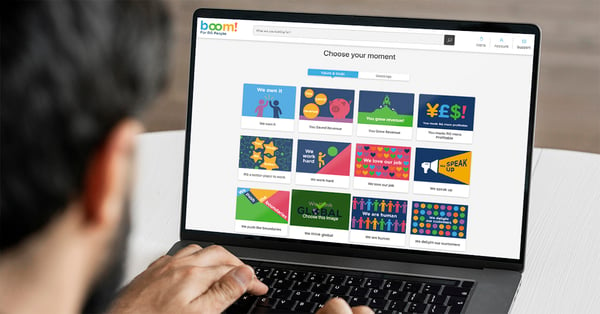One of the most powerful ways to drive a culture of consistent recognition within an organization is to have managers recognizing others on a regular basis. No one wants managers to feel forced, however, to recognize less valuable actions just to check a box on a weekly basis.
I want to share a tip that we provide to new clients that gives managers more reasons to genuinely recognize their teams and provides additional ways to use recognition to build understanding and connection among staff – and drive key business results.
If I were to ask you, "Why do you recognize your employees?" it would likely sound like a silly question – it's probably to acknowledge that person in their efforts. Most of the time, that's what drives us – and not only is this the most common reason, it's a wonderful reason, as well. But if we wait for someone's actions to knock us off our seat, we may not recognize as often as we need to in order to build that culture of continuous appreciation.
So here's a second reason, or a prompt, that drives managers to recognize to educate others within and across groups:
Visibility matters!

Here's an example: I was talking with the manager of an IT group of about 200 people within a 4,000 person company. I asked him why I hadn't seen very many recognition moments posted for his team online, and he shared that, actually, he was pretty good at sharing recognition in person, so he wasn't using the system. He was sharing recognition at the start of regular meetings and as part of one-on-ones, so he didn't see the value of putting it online.
On the surface, that sounds like a good practice – managers directly recognizing their team. But does your team get appreciation from the rest of the organization? Does the rest of the organization understand the value they provide? And at that question, he laughed. Of course not – his team gets called when something's broken. They're more likely to get frustration directed their way than appreciation.
In our conversation, we discussed the value of posting recognition for his team to make it more about the education of the rest of the organization than for employees to feel uniquely appreciated in that moment.
What if everyone knew about their late nights, about the weekends they worked to make system overhauls happen without any downtime, or about the certifications they were receiving?
 We agreed that that was the better use of the system for him and his team. Those one-on-one recognition moments should absolutely continue happening. But he needed to elevate that great work for the rest of the organization to see it. And as he did that, over time, people started to treat his team differently. They saw them as experts that happened to show up when something was wrong, rather than the cause of those problems.
We agreed that that was the better use of the system for him and his team. Those one-on-one recognition moments should absolutely continue happening. But he needed to elevate that great work for the rest of the organization to see it. And as he did that, over time, people started to treat his team differently. They saw them as experts that happened to show up when something was wrong, rather than the cause of those problems.
We've seen a similar dynamic play out in multiple industries – in healthcare, for example, between an emergency department and the rest of the hospital. Nursing units can get frustrated by incomplete paperwork or terse responses when they're interacting with an emergency room team. But the more they were reading stories of the crazy situations that that team deals with on a daily basis, the more likely they were to be generous and understand those communication breakdowns. It really greased the skids of connection and communication between different groups.
Promote actions you'd like to see done more
In hospitality, this might be food that is served with a beautiful presentation. Highlighting those instances will allow managers to inspire pride in their team, as well as ensure the kitchen is reminded about the important last steps for preparing that food.
In a corporate office, it might be those that proactively communicate between groups. This is something we all know we're supposed to do, but the more managers highlight actual examples of this in action – and the more often they do so – the more likely your team will be to take that important communication step.

In manufacturing, this might be preventing safety incidents. We find that, for our clients, it's very easy to thank those that remain calm in escalating or dangerous situations. But it’s also a crucial time to celebrate those employees who prevent those situations from escalating in the first place, and can be a great mission for managers: Look for those that prevent problems and recognize them, as well.
Consider your team’s broader value
So what is something you wish the rest of the organization knew about your team? What is an action that you wish others within your team – or outside your team – did more? Is there a disconnect between what your team does and what the rest of the organization thinks they do? Those may be the recognition missions you adopt in the weeks and months to come to create more genuine, consistent recognition for you in the organization.
To learn more about effective recognition, the Reward Gateway employee engagement platform or other employee engagement tips and tricks, get in touch with us and a member of our team will walk you through our solutions.

%20(1).jpeg) Alexandra Powell
Alexandra Powell



